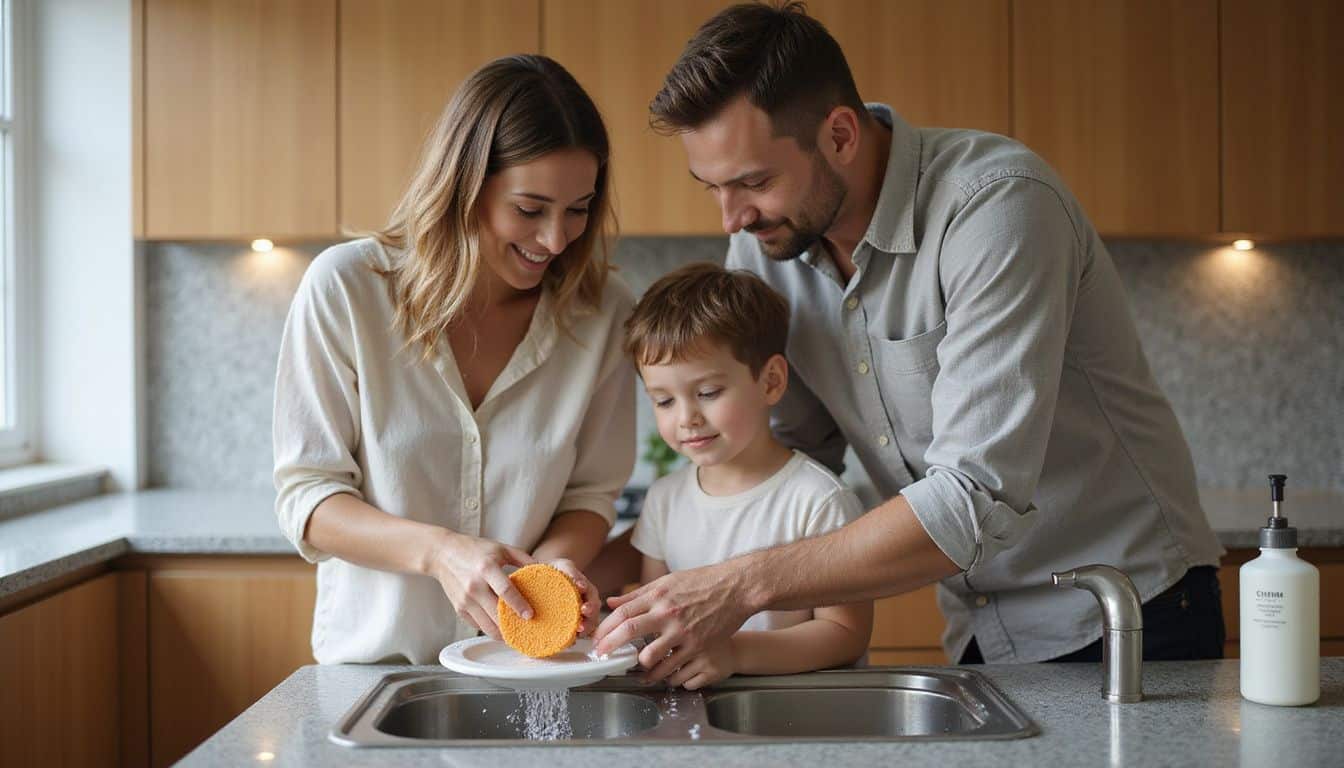Tired of arguing about dirty utensils piling up in the kitchen sink? Teaching children to wash dishes is actually one of their favorite household chores, especially with a fun Montessori-inspired approach.
In this blog, you’ll discover 5 easy steps on how to teach kids to wash dishes that will get your kitchen sparkling, while your child smiles and gains practical knowledge. Keep reading for simple tips that really work.
Key Takeaways
Create a kid-friendly washing area with small gloves, colorful aprons, and sturdy step stools—helps little ones reach the sink and keeps them dry.
First, teach kids to scrape leftover food into the trash—this keeps drains clear, and makes cleaning quicker.
Demonstrate washing dishes using small, circular motions—just fill the sink with water and add 20-25 drops of soap for good bubbles.
Show how to load the dishwasher right—always put plastic items on top so they don’t melt near the hot bottom part.
By 2025, smart gadgets with screens and fun apps will turn dishwashing into playtime, teaching kids about saving water as they clean.
Table of Contents
Preparing to Teach Kids to Wash Dishes
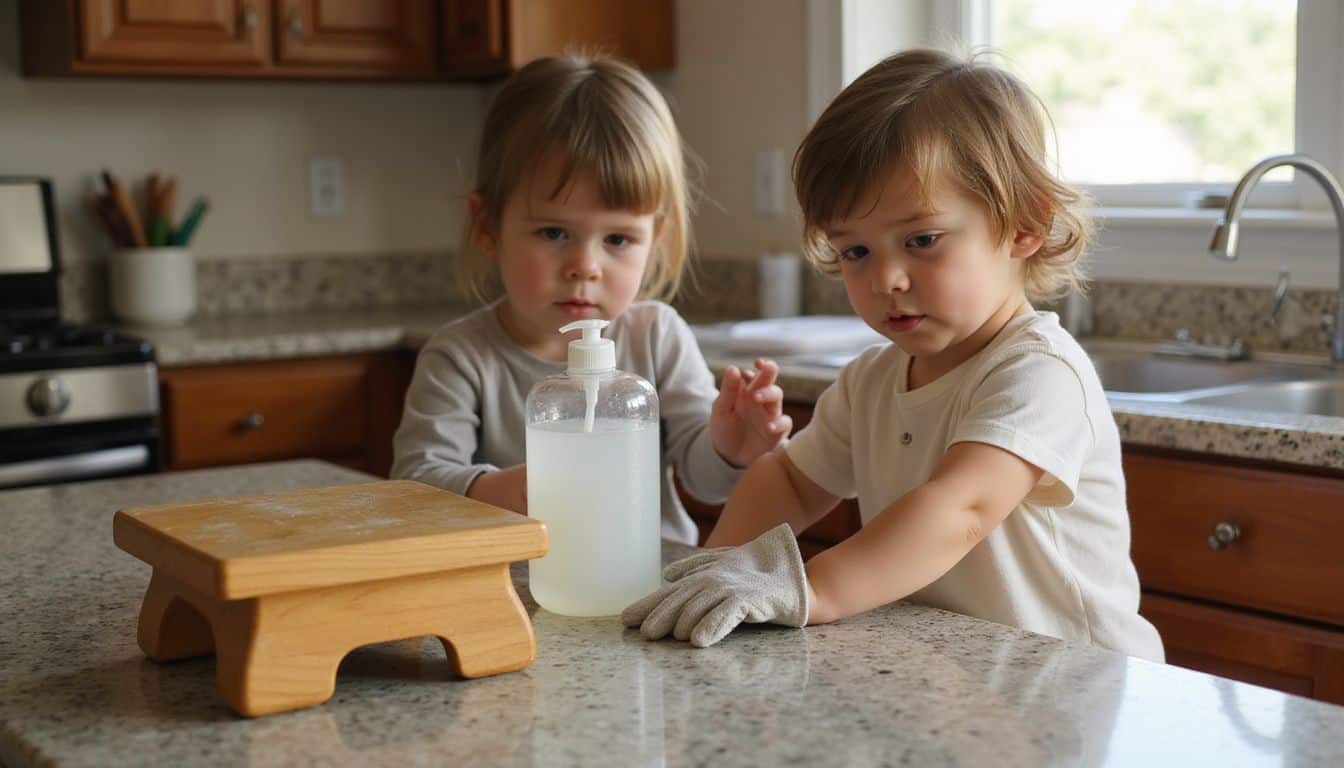
Getting kids ready for dish duty starts with the right setup. You’ll need kid-sized gloves, safe soaps, and sturdy step stools so they can reach the sink in your Nassau County kitchen.
Gather child-friendly dishwashing materials

The right tools can turn dishwashing into a fun task for your kids. Choose safe, kid-friendly items meant for little hands:
- Use a sturdy step stool so your kids can safely reach the sink—perfect for homes around Nassau County.
- Child-sized aprons help keep their clothes dry from water splashes and soap messes.
- Mild dish soap, like Blue Dawn, cleans dishes well but stays gentle on sensitive skin.
- Small, soft washcloths or sponges are easier for small hands to hold onto instead of larger adult-sized scrubbers.
- Plastic cups, bowls, and plates make great starter items while kids practice washing dishes.
- Place a low drying rack within their easy reach, so your kids can safely set down clean dishes without stretching or dropping them.
- Mini kitchen towels fit comfortably in little hands—great for drying dishes like cast iron skillets.
- Kid-sized rubber gloves are great to protect their hands from hot water or harsher soaps.
- Set non-slip mats around the sink to reduce slips and falls on wet kitchen floors.
- Older kids can safely learn to load and run the dishwasher, with your supervision, using dishwasher pods.
Set up a safe and organized washing station
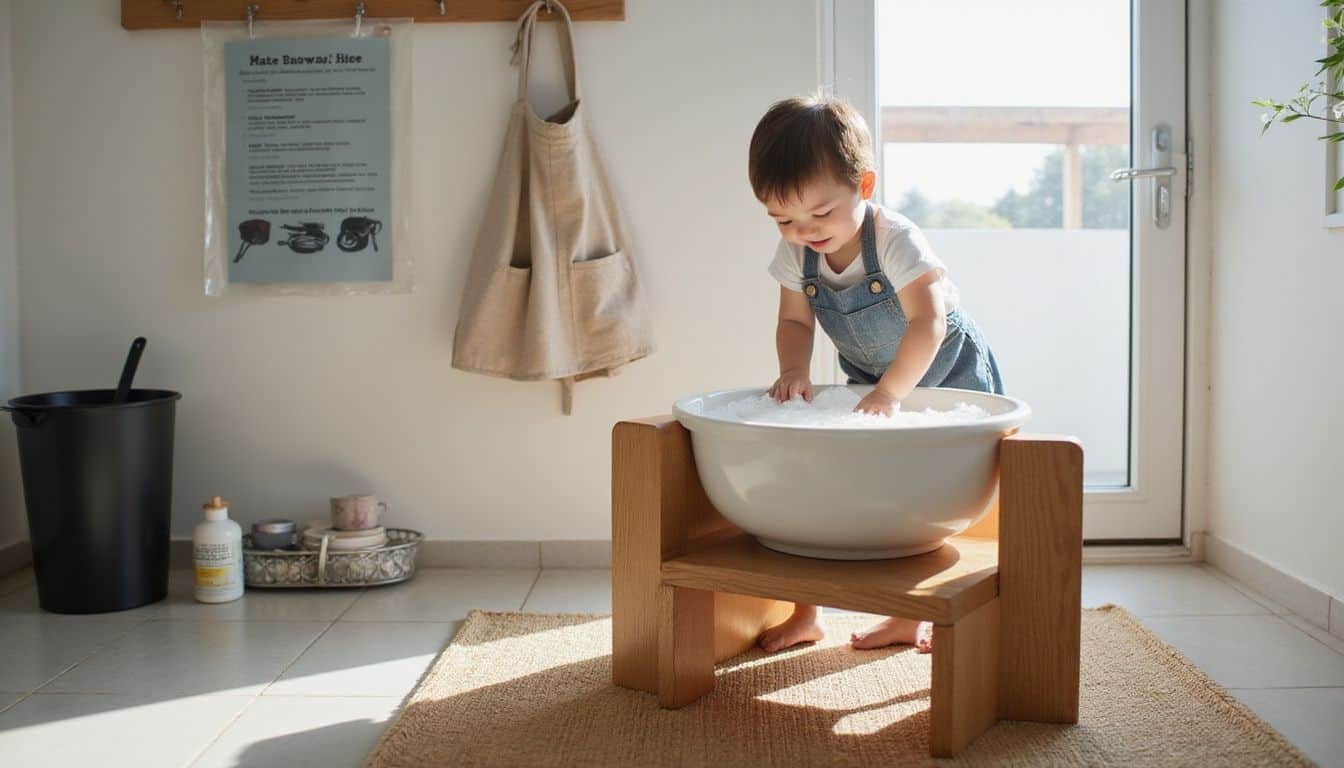
Time to set up a fun and safe dishwashing spot for your little helper. Here’s how to do it right:
- Use a strong, stable step stool by the sink so kids can reach easily—no stretching or accidents.
- Fill half the sink with warm water, then add about 20-25 drops of dish soap for plenty of bubbles—the best part for little washers.
- Move sharp utensils and delicate glassware out of reach and out of sight to keep the washing area safe.
- Group dishes neatly—plates, cups, utensils—beside the sink; that makes grabbing and cleaning easy.
- Place a drying rack nearby, close enough for easy stacking without spills.
- Hang a kid-sized apron on a hook nearby to keep clothes dry and ready for splashes.
- Post simple dishwashing rules with pictures—perfect for kids who don’t read yet.
- Put a small absorbent rug or towel on the floor where they’ll stand, catching drips right away.
- Set a small trash bin beside the sink for scraping leftovers before washing dishes.
- Store extra dish soap somewhere safe, away from kids’ hands, but in easy reach for adults to refill.
Step-by-Step Guide to Hand Washing Dishes
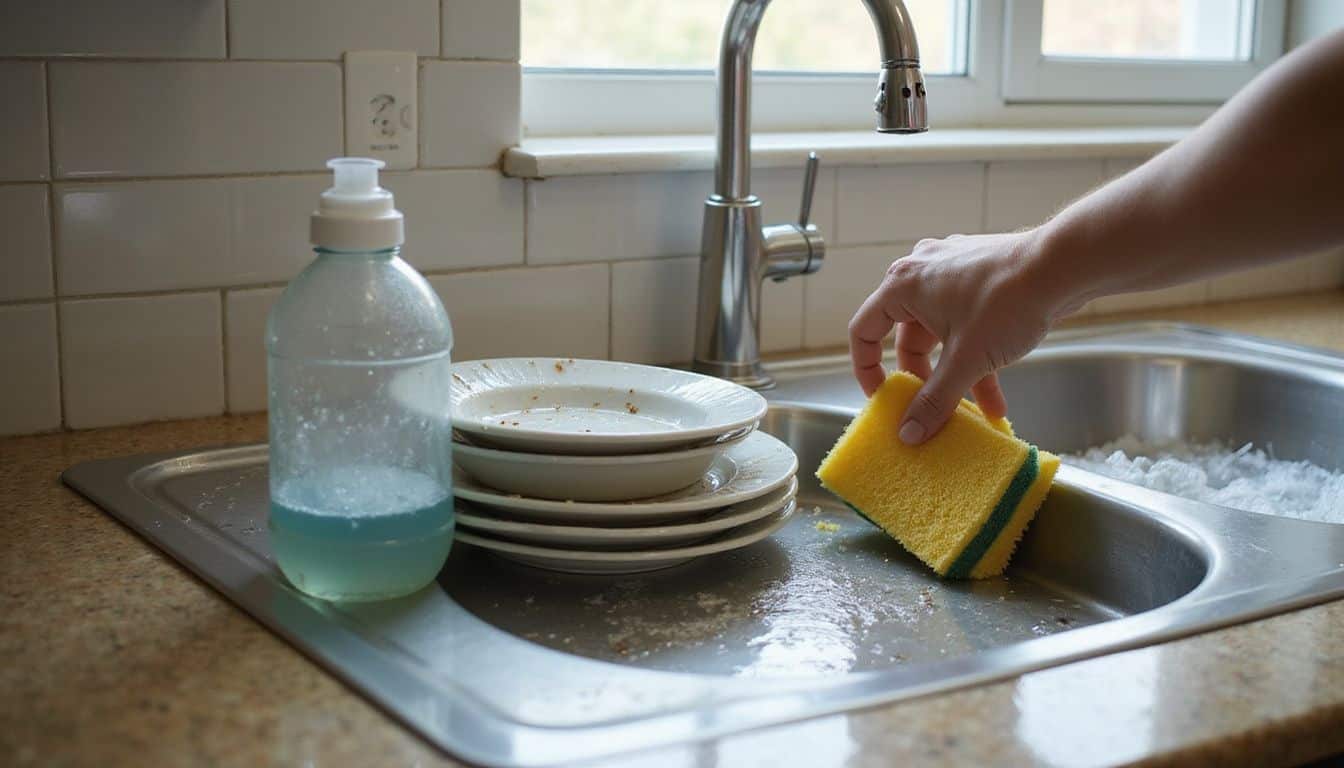
Kids can learn to hand wash dishes with a few easy steps. Our guide shows the right way to scrape, wash, and dry for clean dishes every time.
Rinse and scrape off food residue
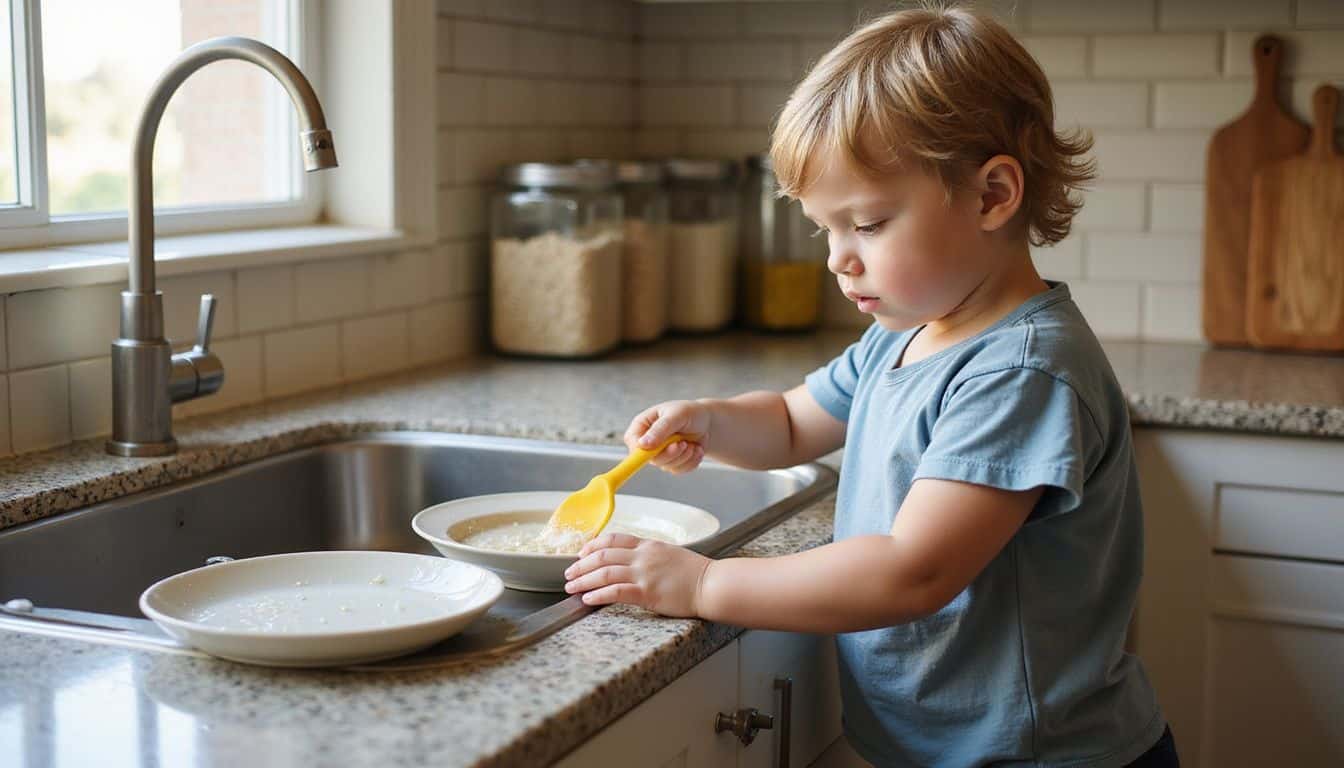
Teach your child to start dishwashing easily—begin by scraping leftover food into the trash or compost bin. This simple habit keeps pipes clear and makes washing faster. My own kids quickly learned this tip, especially after seeing the gross dried-on food! A rubber spatula works great to scrape off plates without scratching them.
These little steps teach lifelong skills.
Next, have your child rinse each dish with warm water. Rinsing clears food bits that could stick onto other dishes. I showed my girls how holding plates slightly tilted helps water flow right off.
Good rinsing means less scrubbing later—and really helps with picky eaters who tend to leave more food behind.
Clean dishes start with proper food removal – it’s the foundation that makes the rest of dish washing so much simpler for little helpers.
Wash dishes with soap and sponge
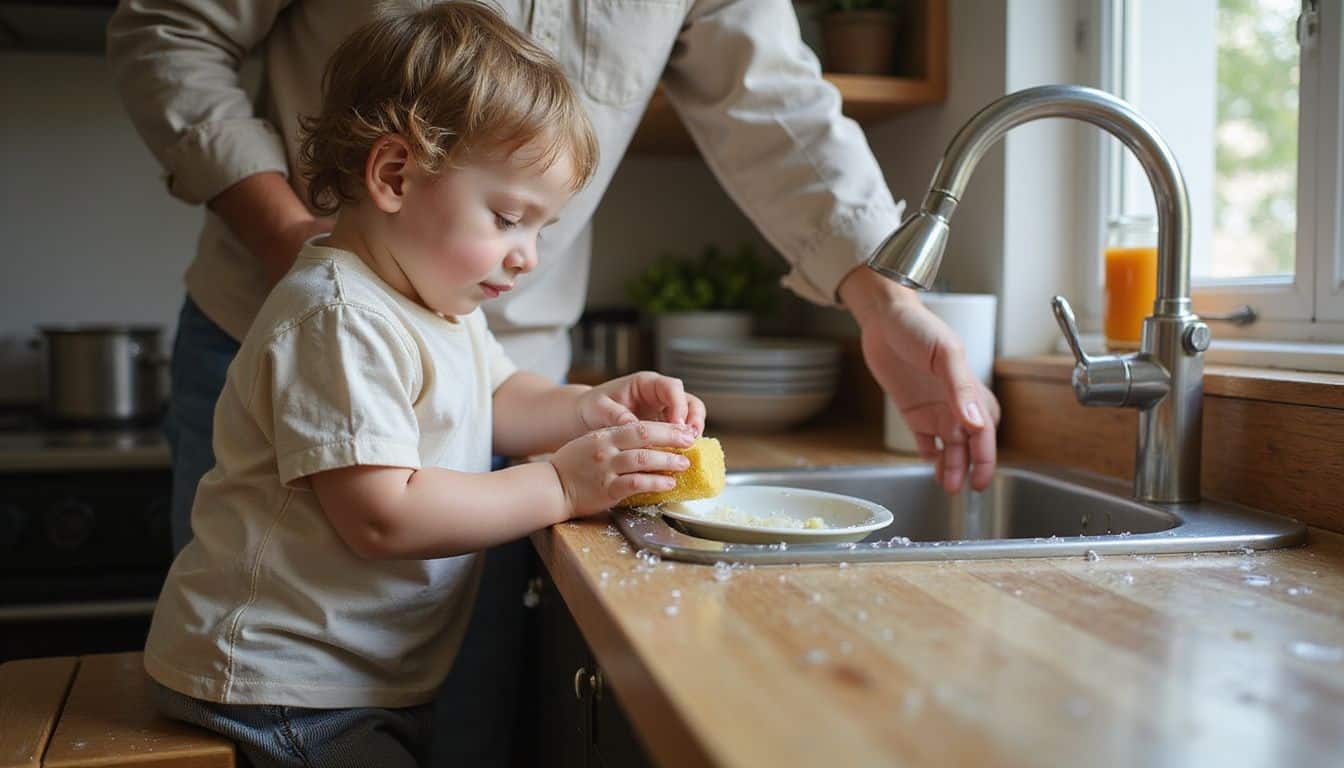
Once you’ve rinsed off the leftover food bits, let’s get started on washing. First, fill your sink with water, then add about 20 to 25 drops of dish soap. This makes the right amount of suds for cleaning dishes—enough soap to break down grease and leftover food spots water alone misses.
Next, put one dirty dish into the sink, and show your child how to clean it with a washcloth. Let kids practice holding dishes firmly but carefully—to stop plates from slipping out of their hands.
Show them how to scrub gently, in small circles, especially on areas where food got stuck. Keep the washcloth damp but not soaking wet, so water doesn’t drip onto the floor. Go step by step to build good habits that stick.
Rinse thoroughly and dry
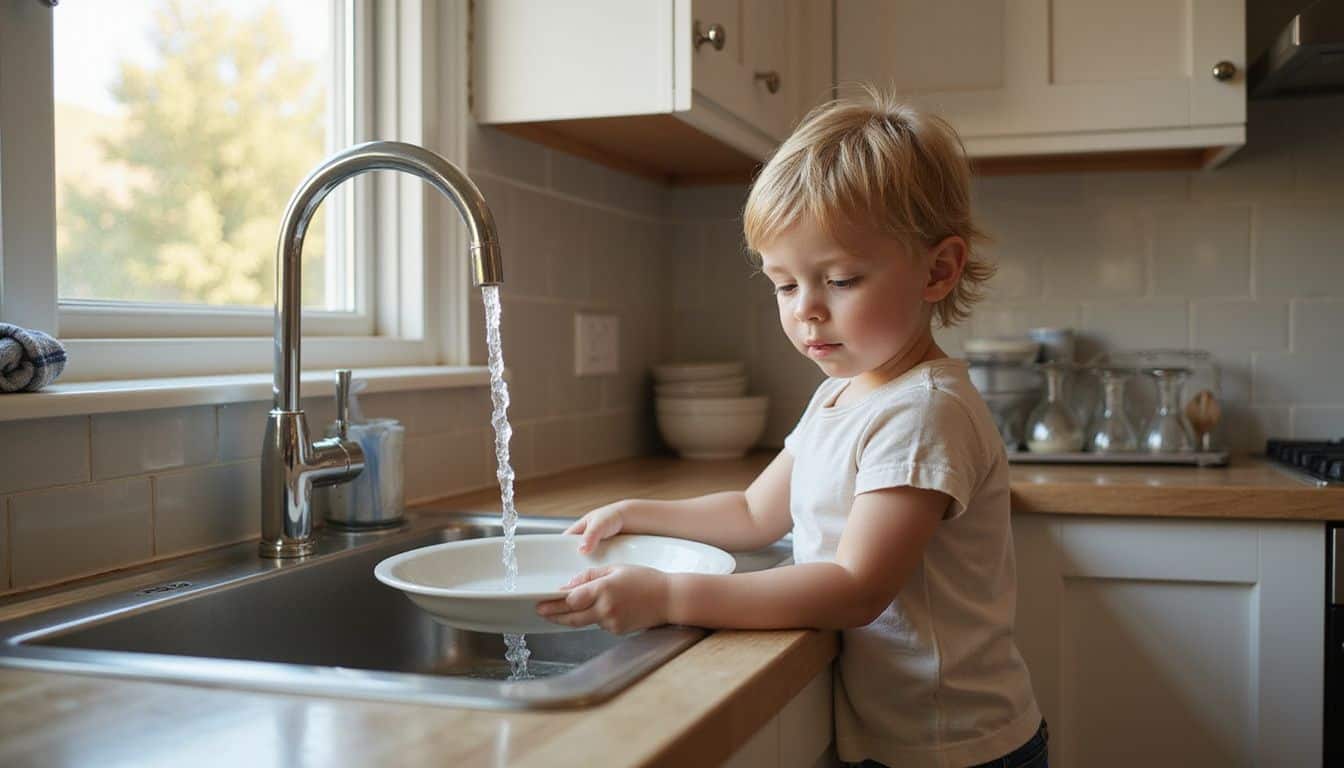
Rinsing dishes needs fresh running water—hot is best, since it cuts grease and kills germs. Show kids how to hold dishes fully under the tap, front and back, to wash soap away. Watching how water runs off helps spot any leftover soap streaks at once.
After rinsing, set dishes on a clean drying rack, leaving space around each item for good airflow and faster drying.
If needed, kids can dry dishes with a clean kitchen towel. Teach them to wipe in one direction, since this keeps water from spreading around the dish. After finishing, kids should drain the sink and wipe away leftover soap bubbles using the wash rag.
They also need to dry their hands well and wipe any wet areas on the floor. Doing this keeps everyone safe and builds helpful kitchen habits. Next up, we’ll cover how to show kids the right way to load dishes into the dishwasher.
Teaching Kids to Load the Dishwasher
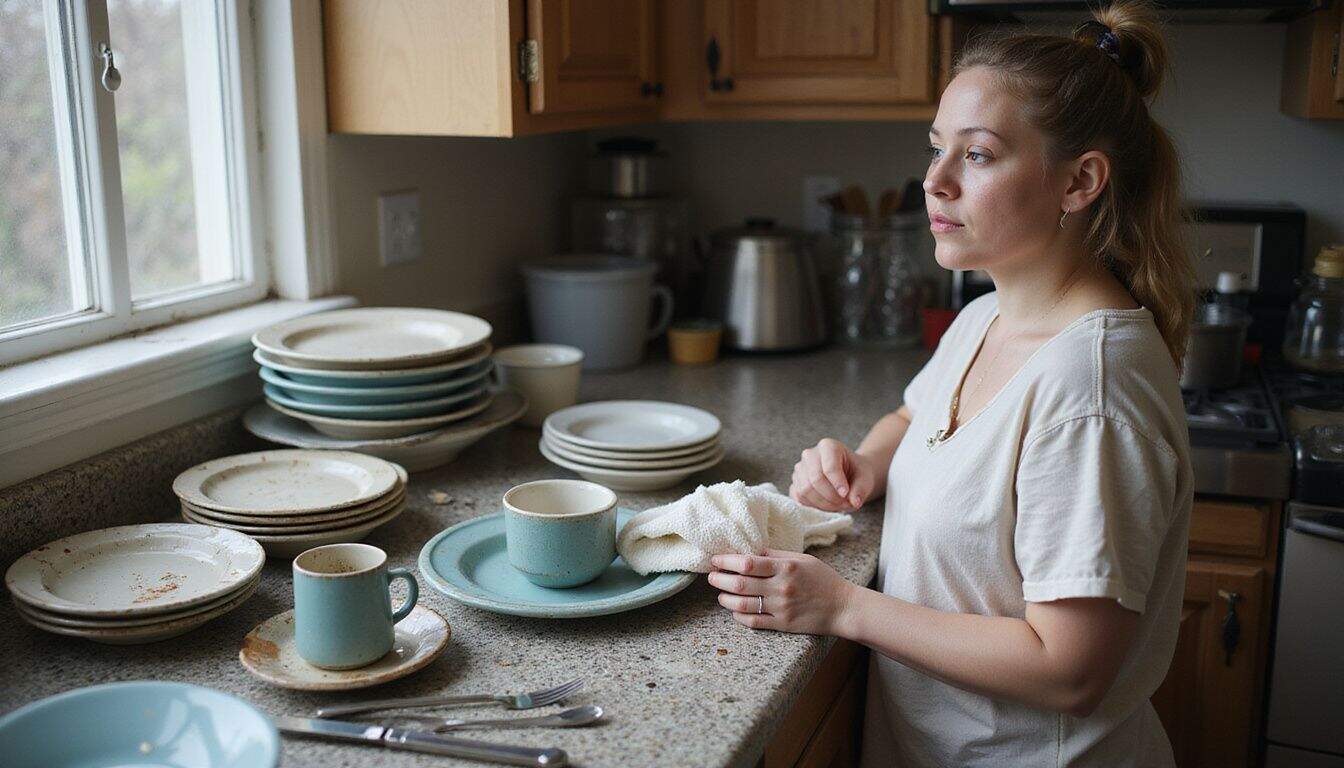
Teaching kids to load the dishwasher right builds good habits for life. Kids need to know where each dish goes for the best clean.
Organize dishes by type for efficiency
Sorting dishes by type speeds up the whole cleaning process. Kids quickly learn to group plates together, cups in another spot, and utensils separately. This simple system shows clearly what to wash first—and exactly where things go afterward.
My daughter got the hang of this at age 9, cutting her cleaning time by half. Learning how to sort dishes early can boost kids’ organization skills for years ahead.
For dishwashers, show kids the basics clearly: cups, plastic bowls, and small pieces on the top rack; bigger items like plates, pots, and pans go onto the bottom. This way, everything stays safe inside the machine.
Kids around 7 or 8 can begin mastering these sorting basics, while 9-year-olds often manage everything easily. Simple sorting rules keep family cleanup quick and smooth.
Place plastic items on the top rack

Plastic bowls, cups, and containers belong on the top rack of your dishwasher. This placement keeps them safely away from the bottom heating element—which can warp or melt plastic.
Kids should understand this basic dishwasher loading rule early on. Before loading, quickly glance at the item’s bottom label to confirm it’s dishwasher safe. Some plastics may note “top rack only”, while others aren’t dishwasher-safe at all.
Children can easily get the hang of this simple step—it helps them load dishes correctly. The top rack is ideal for lunchboxes, sippy cups, and plastic utensils. Sorting by material type creates helpful habits, protecting your kitchen gear long-term.
Many families have a well-used supply of plastic containers… washing these correctly helps them last longer.
How Will Teaching Kids Dishwashing Skills Evolve in 2025?
By 2025, smart dishwashing tools will reshape how kids pick up dish-cleaning skills. Imagine touch-screens on sinks, with fun animations guiding kids on proper scrubbing methods. Special nozzles help children learn about saving water, making them resource-aware as they clean.
Plus, handy apps track a child’s dish-cleaning progress, awarding digital badges or points. These cool tech tools turn chores into games, keeping kids engaged as they learn.
Eco-friendly soaps and brushes made for smaller hands will become common in homes with kids. Even schools may include dishwashing in life-skills classes, using this new tech approach.
Kids could also use VR headsets—practicing dishwasher loading without wasting water. Parents will have an easier time teaching these skills, thanks to all these advances. The main goal stays constant—clean dishes done right—but kids will definitely have more fun getting there.
People Also Ask
What’s the ideal age for kids to learn dish washing?
Kids as young as 4 or 5 can start simple tasks—like rinsing dishes. By 7 or 8, most kids can do the full routine, though they might still need help. Early practice helps build lasting, helpful habits.
How do I make dish washing enjoyable for kids?
Make it playful—think bubbles or their favorite songs. Kids are often motivated by star stickers or rewards they earn each time they finish their dish chores.
Should kids wash dishes by hand or use a dishwasher?
Both methods help kids build life skills. Washing by hand helps kids pay close attention—loading a dishwasher teaches practical skills for daily life. Start by hand first, so kids learn the basics.
What should I do if my child breaks a dish?
Keep calm—breaking dishes sometimes happens during learning. Let your child know it’s fine to make mistakes. Use the experience as a chance to teach care, safety, and responsibility.
References
https://greenlight.com/learning-center/home-and-chores/how-to-wash-dishes
https://childledlife.com/washing-dishes/
https://homemakerssociety.com/teach-your-kids-how-to-hand-wash-dishes/
https://www.homemadesimple.com/kitchen/how-to-wash-dishes-by-hand/
https://www.cleaninginstitute.org/cleaning-tips/dishes/dishwashing-made-easy
https://www.whirlpool.com/blog/kitchen/proper-way-to-load-a-dishwasher.html
https://www.whirlpool.com/blog/kitchen/how-to-use-a-dishwasher.html
